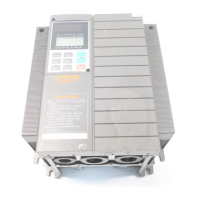2-19
Table 2.8 Continued
Classifi-
cation
Symbol Name Functions
[FMA] Analog
monitor
The monitor signal for analog DC voltage (0 to +10 VDC) is output. The
signal functions can be selected from the following with function code F31.
- Output frequency (before slip compensation)
- Output frequency (after slip compensation)
- Output current - Output voltage
- Input power - PID feedback amount
- DC link bus voltage - Calibration
*Input impedance of external device: Min. 5 kΩ
Analog output
[11] Analog
common
Common terminal for analog input and output signals
This terminal is electrically isolated from terminals [CM] and [Y1E].
(1) Various signals such as inverter running, speed/freq. arrival and over-
load early warning can be assigned to the terminal [Y1] by setting
function code E20. Refer to Chapter 5, Section 5.2 "Overview of Func-
tion Codes" for details.
(2) Switches the logic value (1/0) for ON/OFF of the terminals between [Y1]
and [Y1E]. If the logic value for ON between [Y1] and [Y1E] is 1 in the
normal logic system, for example, OFF is 1 in the negative logic system
and vice versa.
Digital input circuit specification
Figure 2.17 shows examples of connection between the control circuit and a
PLC.
[Y1] Transistor
output
- Check the polarity of the external power inputs.
- When connecting a control relay, first connect a surge-absorbing
diode across the coil of the relay.
[PLC] Transistor
output
power
Power source of +24 VDC to be fed to the transistor output circuit load (50mA
at maximum).
To enable the source, it is necessary to short-circuit between terminals [Y1E]
and [CM].
Can also be used as a 24 VDC power source.
This terminal serves also as a digital input one.
Transistor output
[Y1E] Transistor
output
common
Common terminal for transistor output signal
This terminal is electrically Isolated from terminals [CM] and [11].
Item Max.
ON level 2 V
Operation
voltage
OFF level 27 V
Maximum load current
at ON
50 mA
Leakage current at OFF
0.1 mA

